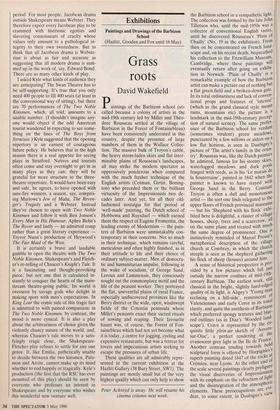Exhibitions
Paintings and Drawings of the Barbizon School (Hazlitt, Gooden and Fox until 16 May)
Grass roots
David Wakefield
Paintings of the Barbizon school (so- called because a colony of artists in the mid-19th century led by Millet and Theo- dore Rousseau settled at the village of Barbizon in the Forest of Fontainebleau) have been consistently underrated in this country, despite the presence of large numbers of them in the Wallace Collec- tion. The massive bulk of Troyon's cattle, the heavy storm-laden skies and flat inter- minable plains of Rousseau's landscapes, all may strike the modern spectator as oppressively ponderous when compared with the much fresher technique of the English artists (Cotman, Girtin, Boning- ton) who preceded them or the brilliant virtuosity of the Impressionists two de- cades later. And yet, for all their old- fashioned nostalgia for that period of 'well-made' painting, the Dutch school of Hobbema and Ruysdael — which earned them the respect of Eugene Fromentin, the leading enemy of Modernism — the pain- ters of Barbizon were unmistakably con- temporary in their concerns. Not so much in their technique, which remains careful, meticulous and often highly finished, as in their attitude to life and their choice of ordinary subject-matter. Men of democra- tic and humanitarian impulse, following in the wake of socialism, of George Sand, Leroux and Lammenais, they consciously sought out the commonplace motif and the life of the peasant worker. They portrayed the flat, uneventful plains of rural France, especially undiscovered provinces like the Berry district or the wide, open, windswept fields of the Cotentin peninsula where Millet's peasants enact their sacred rituals of sowing and reaping. Their favourite haunt was, of course, the Forest of Fon- tainebleau which had not yet become what it is today, a centre for jogging, cycling and expensive restaurants, but was a retreat for lovers and impecunious artists seeking to escape the pressures of urban life.
These qualities are all admirably repre- sented in the current exhibition at the Hazlitt Gallery (38 Bury Street, SW1). The paintings are mostly small but of the very highest quality which can only help to show Peter Ackroyd is away. He will resume his cinema column next week. the Barbizon school in a sympathetic light. The collection was formed by the late John Tillotson who, until the mid-1950s was a collector of conventional English tastes, until he discovered Rousseau's 'Plain of Chailly' (No. 19 in the exhibition). From then on he concentrated on French land- scape and, on his recent death, bequeathed his collection to the Fitzwilliam Museum, Cambridge, where these paintings will eventually return after going on exhibi- tion in Norwich. 'Plain of Chailly' is a remarkable example of how the Barbizon artist can make a picture out of nothing but a flat green field and a broken-down gate. In its total ordinariness and lack of conven; tional props and features of 'interest (which in the grand classical style meant ruins, mountains etc) the picture is a landmark in the mid-19th-century perceP- tion of natural scenery. The same prefer- ence of the Barbizon school for verdant (sometimes virulent) green meadows, punctuated by a few willows or alders on a low flat horizon, is seen in DaubignY's picture of 'The artist's family in the coun- try'. Rousseau was, like the Dutch painters he admired, famous for his stormy skies, waterlogged meadows and dark pools fringed with reeds, as in his `Le marais de la Souterraine', painted in 1842 when the painter is known to have stayed with George Sand in the Berry. Constant Troyon is often a dull and monotonous artist — the sort one finds relegated to the upper floors of French provincial museums — but his 'Shepherd with his flock' exhi- bited here is delightful, a cluster of village houses, sheep, trees and a scarecrow, all on the same plane and treated with much the same degree of prominence. One !s instinctively reminded of Marcel Proust s metaphorical description of the village church at Combray, in which the church steeple is seen as the shepherd gathenng his flock of sheep (houses) around him. A sense of historical perspective is pro- vided by a few pictures which fall Just outside the narrow confines of mid-9th- century Barbizon. The earliest work, 011 classical in the bright, slightly hard-edged quality of its light, is Aligny's 'Young mall reclining on a hill-side', reminiscent 0! Valenciennes and early Corot in its tonal, clarity, and quite the antithesis of Barbizon which preferred spongy textures and blur- red outlines (as in Diaz's 'Wooded land- scape'). Corot is represented by the ex- quisite little plein-air sketch of'Auvers- sur-Oise', a perfect rendering of the evanescent grey light in the Ile de France; Another contrast tending towards bold sculptural form is offered by Harpignies superb painting dated 1847 of the rocks at Cremieu, near Lyons. At the other end et the scale several paintings clearly prefiere the visual discoveries of ImpreSS10isbt with its emphasis on the refraction of and the disintegration of the atmospheri.e elements. These preoccupations areevi . dent, to some extent, in Daubigny's view of the `Beach at Villerville' (1875), but more markedly in Chintreuil's study of 'Apple trees in blossom' — a favourite theme with Monet — and in Cals's 'Cliffs near Dieppe', which directly anticipates Monet's studies of Etretat.



















































 Previous page
Previous page